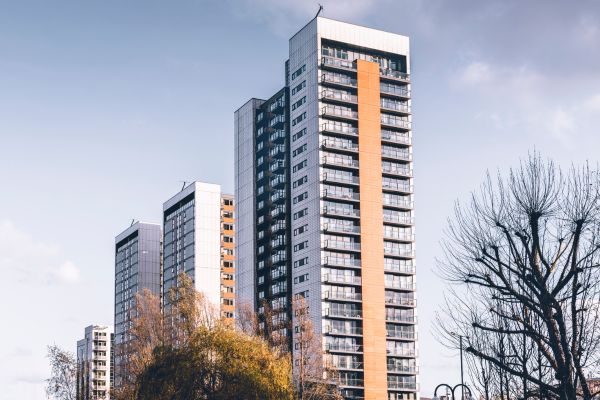Building Safety Act 2022: A quick guide
Whilst it may not be the hottest topic of conversation over a Sunday roast, the Building Safety Act is a vital piece of legislation designed to make UK buildings safe.

Having gone through various iterations and updates, the latest 2022 version was recommended by Dame Judith Hackitt in her review of fire safety and building regulations back in 2018.
What is the Building Safety Act 2022?
The Grenfell Tower tragedy in 2017 put building design and maintenance firmly under the microscope. The new Building Safety Act 2022 has come about as a direct consequence of the disaster that claimed the lives of 72 people and injured many others.
Fire safety throughout high-rise, higher-risk buildings has became a number one priority, with cladding issues particularly highlighted in the media. The new Building Safety Act 2022 came into force on the 1st April 2023 to work alongside the Fire Safety Act 2021.
Why is the Building Safety Act 2022 important?
The Building Safety Act 2022 focuses on these main areas by making sure that:
- Buildings are designed and maintained to the highest safety standards.
- People who have the responsibility of managing and overseeing works to high-risk buildings are competent and well trained.
- Higher-risk buildings are safely constructed according to the needs of the occupants.
- Standards, legislation and guidance are clear.
- Residents are at the heart of building safety.
The Building Safety Act 2022 is essentially about making sure people feel completely safe and secure in their homes. It’s also something that we at Glide are well aware of and take very seriously.
Who does the Building Safety Act 2022 apply to?
The Building Safety Act 2022 affects building owners and managers, as well as those working across construction such as builders, contractors and designers.
What are the key points of the Building Safety Act 2022?
Briefly, there are several new updates that those in the property industry need to be aware of:
Limitation
If a property is considered “unfit for habitation” a claim can be brought under the Defective Premises Act 1972. However, the Building Safety Act 2022 contains new legislation that extends the time limit during which this can be done.
This works in a couple of ways. Firstly, any claims under the Defective Premises Act that relate to a building that was completed after the Building Safety Act became law can be made up to 15 years from the date of Practical Completion. This is instead of the usual 6 years. Furthermore (and this is a bit more controversial), there is now a retrospective 30-year limitation period relating to DPA claims on buildings that were completed prior to the Act kicking in. This could have big consequences for contractors and developers of projects from decades ago, where a claim would previously have been discounted due to too much time passing.
Higher-risk buildings
We’ve already touched on the phrase “higher-risk buildings” but the Building Safety Act 2022 defines these types of buildings more clearly.
Basically, the Act says that to be higher-risk, a building must have at least 2 residential units and also:
- Have 7 storeys or more, or,
- Be at least 18 metres high
Each building also needs to have a specific “Accountable Person”, who is responsible for making sure structural and fire safety is managed properly throughout the entire building. It’s an important role and could be either a person (or persons) or a company. Either way, they will own or manage common areas of the building and be legally responsible for repairs.
Section 38 of the Building Act 1984
This means that someone can make a claim if they are physically injured or if their property is damaged because building regulations were breached at the time the building was constructed. It’s not something that has actually been implemented before, but is now in force. It also applies to all buildings (whereas the Defective Premises Act only applies to dwellings).
Like the DPA, the limitation period is 15 years. However, the 30-year retrospective limit doesn’t apply.
Refurbishment works
A new section 2A of the DPA now exists in the new Building Safety Act which is again important to be aware of. Where the DPA used to only apply to new buildings, it now extends potential liability to extension or refurbishment works as well.
Building Liability Orders
This means potential joint and several liability is given to associated companies, for example successor companies, related group companies or parent companies. It relates to any claim that is made under the DPA, section 38 of the Building Act, or claims relating to a building that is considered unsafe. It’s a clause that’s more likely to come up if the original developer has gone bust for instance.
The “Golden Thread”
This is something that’s relevant to the Accountable Person (or persons) we mentioned earlier.
In a nutshell, the Accountable Person has a duty to keep a “golden thread” of information about the high-risk building they look after. It needs to include things like latest fire safety information, as well as up-to-date details about the building’s safe design, maintenance and management.
RICS has recently published a handy article on this that you might find useful: Weaving the golden thread for building safety.
Where can I find more information?
We’ve put this article together as a quick guide to the Building Safety Act 2022 and what it means. But it’s a pretty big area of legalese which can take some time to digest.
We recommend taking a look at the Government’s Building Safety Act page, as well as the Building Safety Act information centre on the RICS website. There’s also the Building Safety Act 2022 Advice & Guidance page on the CIOB website which contains further details and some useful FAQs.
Need advice about any area of property management?
The expert Glide team are here to help. Find out more about our tailored services or call 0161 393 2891.
